BATHROOM REMODELING
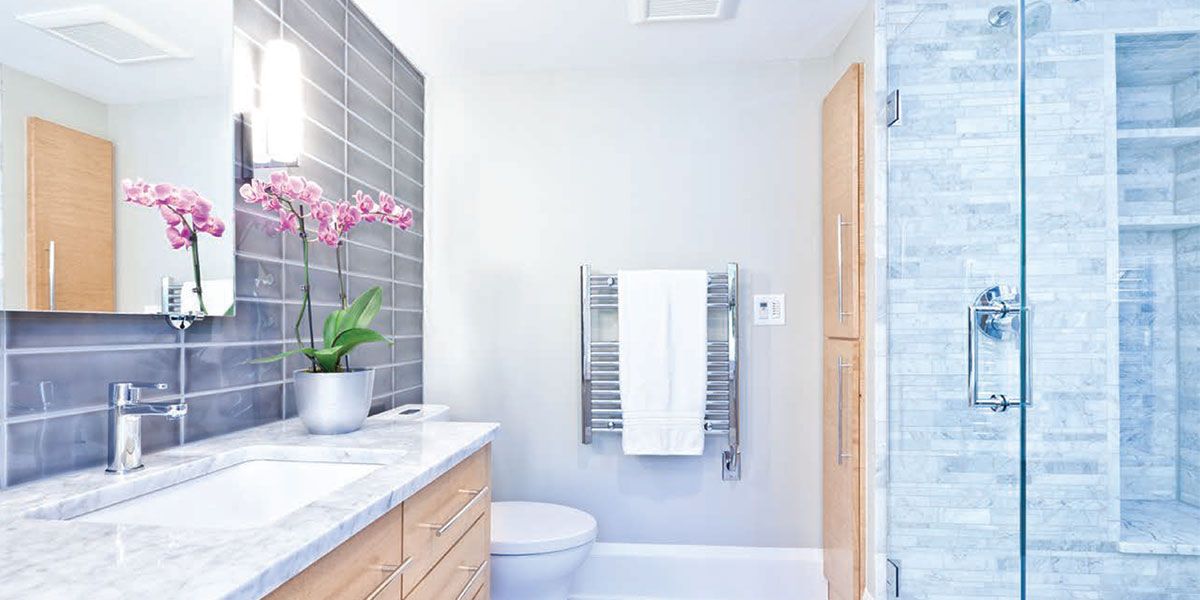
What’s Trending?
THE PROS AND CONS OF WET ROOMS, BIDETS AND JETTED TUBS
When it comes to places in a home that are used frequently, few outrank our bathrooms. Morning routines there prepare us to tackle each day. At day’s end, a get-ready-for-bed ritual is key to a good night’s sleep. And multiple return visits will likely use shower or tub, sink and commode to help keep us progressing comfortably through each day’s appointments and activities.
That’s why bathrooms are right up there with kitchens as frequent choices for home improvement.
Photos: Courtesy Of Construction Marketing
Common remodels
“Indeed, bathrooms are our most common remodel,” notes Mike Bryant, co-owner of Construction Marketing in Hardy. Many of those clients, he says, have dated bathrooms with fiberglass tubs and showers, rarely-used corner “garden” Jacuzzis, worn-out vanities with Formica countertops, and floors that need an upgrade. They now are opting for decorative tile showers with frameless glass doors, vanity cabinets with innovative storage and stone countertops, and tile floors with low-maintenance epoxy grout.
“Today’s remodelers are seeking a spa-type experience in their own homes, a place to decompress from the stresses of their days with luxurious ‘me time,’” Bryant summarizes. He uses the term “wet area” to describe combined bath and shower space with fully waterproof, sloped-to-drainage non-skid tile floors (with no curbs that might preclude easy access later in life) and wall tile extending 42″ or more up from the floor.
Locker-room-style shower areas with no doors were the rage a few years ago but, he cautions, “…many who tried that ended up missing the heat and humidity retention that enclosed showers offer.”
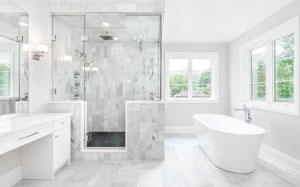 A free-standing tub to replace a seldom-used Jacuzzi will likely take less space, Bryant notes, “…and they can add stunning elegance to a bath remodel. But they can be difficult to get in and out of, especially as the owners age.” Remodelers, he says, might consider using a shower with a bench seat (perhaps heated), convenience niches and multiple showerheads to sub for a tub, which is likely available elsewhere in the home for anyone needing to bathe small children.
A free-standing tub to replace a seldom-used Jacuzzi will likely take less space, Bryant notes, “…and they can add stunning elegance to a bath remodel. But they can be difficult to get in and out of, especially as the owners age.” Remodelers, he says, might consider using a shower with a bench seat (perhaps heated), convenience niches and multiple showerheads to sub for a tub, which is likely available elsewhere in the home for anyone needing to bathe small children.
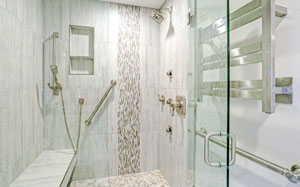 With today’s technology and upscale fixtures, a spa-like bathroom can go as luxe as the budget allows — with multi-function showerheads and body sprays, wireless audio, in-mirror TV, color-sequencing mood lighting, even aromatherapy. “Always include a hand-held [showerhead], not only for bathing convenience but also for easy wall wash-down,” Bryant says.
With today’s technology and upscale fixtures, a spa-like bathroom can go as luxe as the budget allows — with multi-function showerheads and body sprays, wireless audio, in-mirror TV, color-sequencing mood lighting, even aromatherapy. “Always include a hand-held [showerhead], not only for bathing convenience but also for easy wall wash-down,” Bryant says.
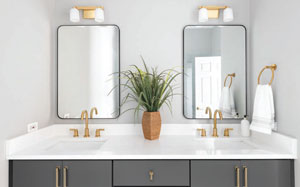 Luxury bath vanity countertops, like those in upgraded kitchens, typically use stone or the usually less-expensive faux stone for both eye appeal and durability. A cascading waterfall faucet, perhaps combined with a surface-mounted vessel sink, is an eye-catching touch. Upscale primary baths call for a pair of sinks, sometimes located in separate vanities.
Luxury bath vanity countertops, like those in upgraded kitchens, typically use stone or the usually less-expensive faux stone for both eye appeal and durability. A cascading waterfall faucet, perhaps combined with a surface-mounted vessel sink, is an eye-catching touch. Upscale primary baths call for a pair of sinks, sometimes located in separate vanities.
Plan ahead
Rhonda Hull of Wall Construction in Madison Heights encourages anyone planning a bathroom remodel to look toward the future — of the project itself and of years of living with the modifications.
“Short term,” she says, “the homeowner/remodeling team must carefully assess what new or modified plumbing and electrical may be required by layout or fixture changes you are considering. Failing to anticipate and deal with them up front will have significant cost impact.”
Also important, Hull says, is thinking far into the future about bathroom design needs. “Yes, that may well lead to installing a curb-free easy-access shower with sit-down bathing accommodation. A ceiling-mounted heat lamp will also keep an elder user more comfortable.”
Other things to consider: ADA-approved taller toilets become a blessing for those with arthritic or replaced knees and hips. Weight-bearing railings near commodes and grab handles in showers also help address the strength and balance effects of aging. “You may not need those assists right now, but incorporating them in this remodel may preclude need for another one 10 or more years out.”
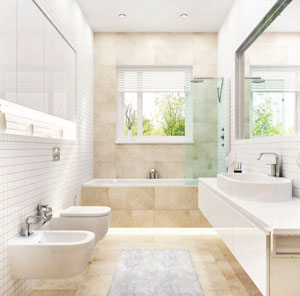 To bidet or not?
To bidet or not?
Bathroom remodels that either add or free up floor space often enable the possibility of adding a fixture for convenient “down there” cleansing. Danielle DeBoe Harper, a spokesperson from upscale fixture manufacturer Moen, recently told Forbes: “I think we’re finally wising up to what the Europeans have long been enjoying: total clean and total comfort.”
Another option: upgrading the toilet fixture itself to one with extra flushing oomph (Japanese-made TOTO toilets are highly regarded for this) and targeted spray washing and drying capabilities. A wide range of toilet seats with built-in cleansing features are also available (visit myOMIGO.com to see add-on sprayers starting at $39 and fully-featured cleansing toilet seats at around $500). Owner testimonials indicate this upgrade borders on “life-changing.”
Regardless of specific arrangement and fixtures chosen, most any bathroom upgrade is a sound investment that will make a home more functional and appealing for years to come … and certainly more marketable when that need eventually materializes. ✦
ADA-approved, Bathroom Remodeling, bidet, decorative tile showers, frameless glass doors, free-standing tub, innovative storage, stone countertops, tile floors, vanity cabinets, wet area







